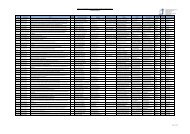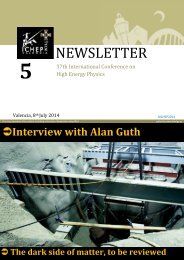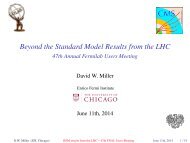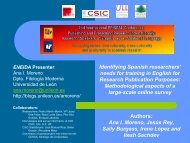PW_mar13_sample_issue
PW_mar13_sample_issue
PW_mar13_sample_issue
You also want an ePaper? Increase the reach of your titles
YUMPU automatically turns print PDFs into web optimized ePapers that Google loves.
physicsworld.com<br />
UK<br />
Cumbria rejects hosting nuclear-waste repository<br />
The UK government will have to<br />
look elsewhere to store its mounting<br />
nuclear waste after plans were<br />
rejected to assess sites in Cumbria<br />
for a £12bn underground nuclearwaste<br />
repository. On 30 January<br />
seven of the 10 members of Cumbria<br />
County Council cabinet voted<br />
against a proposal to build an underground<br />
laboratory in the region that<br />
would have acted as a testbed for a<br />
full-scale storage. District councils<br />
in west Cumbria are now hoping that<br />
the veto – the second in 14 years –<br />
will be overruled by the government.<br />
The UK has been generating<br />
nuclear waste since its first nuclear<br />
power station fired up in 1956. Since<br />
then the country has accumulated<br />
some 470 000 m 3 of waste, which<br />
could remain dangerously radioactive<br />
for up to a million years. Most<br />
of the high- and intermediate-level<br />
waste is currently in temporary<br />
above-ground storage at the Sellafield<br />
nuclear- reprocessing site in<br />
west Cumbria. The UK government,<br />
however, would like to find a<br />
permanent place to store the waste<br />
because of fears that the storage at<br />
Sellafield is deteriorating. Indeed,<br />
last year the UK’s National Audit<br />
Office reported that Sellafield’s<br />
storage posed an “intolerable risk”<br />
to people and the environment.<br />
Cumbria has been seen as a possible<br />
site to permanently store the<br />
waste underground at depths of<br />
up to 1 km because of the existing<br />
nuclear facilities at Sellafield. However,<br />
some geoscientists are opposed<br />
to underground storage in the region<br />
because it is thought to contain<br />
unstable geology such as rock fractures,<br />
which can allow the spread of<br />
waste-leeching groundwater. There<br />
are also concerns that underground<br />
waste would threaten tourism at the<br />
nearby Lake District National Park.<br />
Stuart Haszeldine, a geoscientist<br />
at the University of Edinburgh who<br />
has investigated Cumbria’s suitability<br />
for underground nuclear-waste<br />
storage, told Physics World that he<br />
was pleased with the outcome. “It<br />
was quite unexpected to win,” he<br />
says. “I didn’t think Cumbria County<br />
Council would have such good judge-<br />
Risk concerns<br />
Cumbria in the UK is<br />
already home to the<br />
Sellafield nuclear<br />
reprocessing site,<br />
which closely<br />
monitors its<br />
environmental<br />
impact, but now the<br />
region’s council has<br />
rejected a proposed<br />
£12bn underground<br />
nuclear-waste<br />
repository.<br />
Space science<br />
Satellite sets path for South Korean space missions<br />
South Korea has succeeded in launching<br />
a satellite into orbit after months of<br />
delays and following two failed attempts<br />
in 2009 and 2010. The probe – dubbed<br />
the Science and Technology Satellite<br />
2C (STSAT-2C) – took off at the end of<br />
January from the Naro Space Center,<br />
located around 480 km south of Seoul.<br />
Scientific payloads aboard the probe<br />
include an instrument to monitor<br />
radiation levels as well as an altimeter<br />
to provide precise information about the<br />
satellite’s orbit.<br />
Shortly after lift-off, the Korean<br />
ministry of education, science and<br />
technology announced that STSAT-2C<br />
had successfully deployed in a low-Earth<br />
orbit, while contact with ground stations<br />
was made 11 hours later, confirming<br />
the target orbit of 297 km by 1512 km.<br />
“[The rocket] proved that Korea has<br />
the ability to launch a space vehicle.<br />
This space technology represents<br />
the [high] standard of our country’s<br />
science and technology,” Yeong Hak<br />
Kim, a government official at the Korean<br />
ministry of education, science and<br />
technology, told Physics World.<br />
The probe was launched by Korea’s<br />
Space Launch Vehicle (KSLV-1), also<br />
known as Naro, which is a two-stage<br />
carrier rocket that, when fully loaded,<br />
stands 33 m tall and has a mass of<br />
around 140 000 kg. The first stage of the<br />
launch vehicle was designed and built<br />
by Russia’s Khrunichev State Research<br />
and Production Space Center, while<br />
the second stage was developed by the<br />
The project is a<br />
demonstration<br />
of South<br />
Korea’s<br />
growing space<br />
prowess<br />
News & Analysis<br />
ment.” Haszeldine believes that<br />
other parts of the UK would be more<br />
geologically suitable for the con-<br />
struction of an underground storage<br />
facility, such as around the defunct<br />
nuclear power station in Oldbury,<br />
near Bristol.<br />
Many, however, are frustrated by<br />
the vote’s outcome. UK energy secretary<br />
Edward Davey says it was “disappointing”,<br />
adding that the decision<br />
will “not undermine prospects<br />
for new nuclear power stations”.<br />
Meanwhile, council leaders from<br />
Copeland – the district that hosts<br />
Sellafield – and from neighbouring<br />
Allerdale have written to the government<br />
to ask if there is still a way that<br />
west Cumbria can be considered for<br />
long-term nuclear-waste storage.<br />
Councillor Elaine Woodburn of<br />
Copeland told Physics World that<br />
more than two-thirds of Copeland<br />
residents wanted to see west Cumbria<br />
reconsidered, and that some<br />
geological experts would like to see<br />
a more detailed investigation. “The<br />
impact of hosting over 70% of this<br />
country’s waste is felt economically,<br />
environmentally and socially,” says<br />
Woodburn. “Whether it stays or<br />
goes, it affects us, so we need to be<br />
part of the solution. Whether [that]<br />
solution is in Copeland, I don’t know;<br />
we don’t have the facts to allow that<br />
decision to be taken.”<br />
Jon Cartwright<br />
Korea Aerospace Research Institute.<br />
The immediate scientific value of<br />
the satellite will be relatively small<br />
with the project being more of a<br />
demonstration of South Korea’s growing<br />
space prowess. Indeed, North Korea’s<br />
apparent success in launching a longrange<br />
rocket in January put pressure<br />
on Seoul to ensure that KSLV-1’s space<br />
flight went to plan. Both countries on<br />
the Korean peninsula are now members<br />
of the exclusive group of 11 nations that<br />
have independently launched satellites<br />
from their own territory. However, South<br />
Korea will still have to make significant<br />
progress before comparisons can be<br />
drawn with other space-faring nations<br />
such as China and Japan.<br />
Toby Brown<br />
Physics World March 2013 11<br />
Sellafield Ltd








